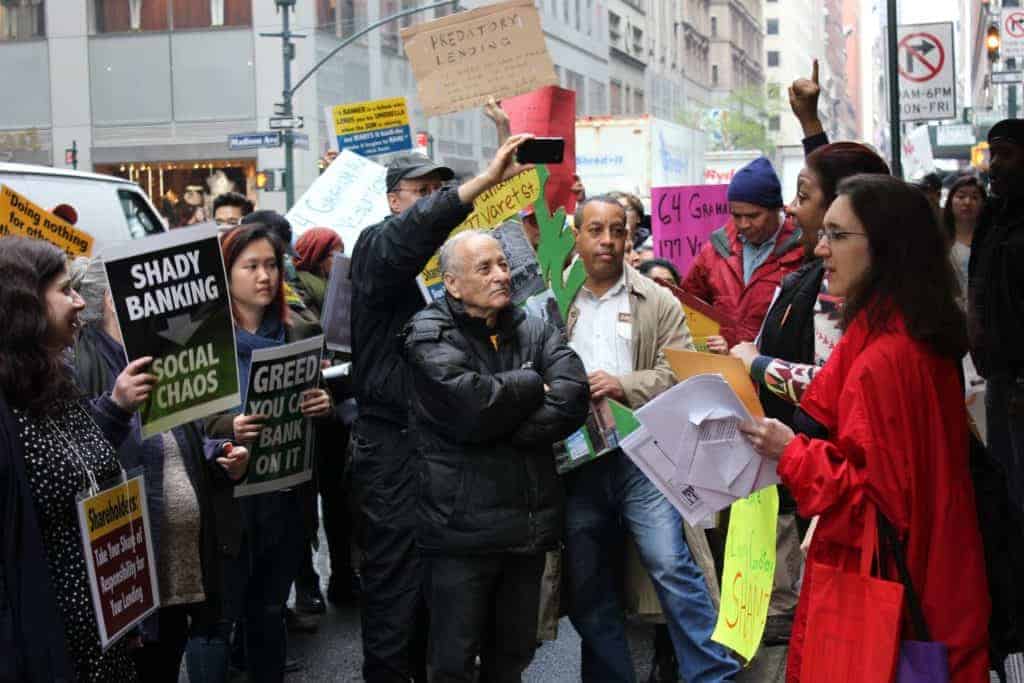Jaime Weisberg is the senior campaign analyst at the Association for Neighborhood & Housing Development (ANHD), a member organization of the National Community Reinvestment Coalition (NCRC). The ANHD acts as a collective of over a hundred affordable housing developers and tenant organizing groups within New York City. Weisberg was recently featured in a Next City article where she emphasized the importance of bank oversight, as well as giving banks credit for their good deeds and calling them out on the things they need to work on.
Q: How and when did you first get into the field of bank reinvestment work?
I was organizing in Queens before and after the 2008 financial crisis and saw the impact of irresponsible activities by banks and other financial institutions, but bank reinvestment wasn’t a core part of my work at that time. The organization I led, the Queens Congregations United for Action, was a member of ANHD. I entered the field of bank reinvestment when I began working at ANHD in 2012, where I have been learning every day since about the importance of responsible banking and working to increase responsible reinvestment to benefit low- and moderate-income people and neighborhoods, immigrants and communities of color.
Q: What does your position and work as senior campaign analyst for the ANHD entail?
I am responsible for ANHD’s bank reinvestment work, providing research and support to member organizations regarding bank mergers and CRA. I help our member organizations push banks to increase access to banking, loan products and investments in community development and work with organizers to combat predatory equity lending that threatens rent-stabilized affordable housing. Currently, I am working with our members to protect and strengthen CRA, which includes fighting against the Office of the Comptroller of the Currency’s attempts to weaken the law. Day-to-day, I can be found analyzing bank data, commenting on bank CRA exams and mergers and helping our members effectively use the data to increase and improve the quality of bank reinvestment in NYC.

Q: Could you provide some insight into your recent CRA comment letter to Signature Bank? How was this case different, and why did it warrant a 9,000-word letter?
This was a bank that we have been working with and trying to change for a number of years now, so this wasn’t out of the blue. We have been pushing Signature Bank to change their lending practices since we noticed that they were lending to a particular set of bad-acting landlords. They’re also one of the biggest lenders in New York City, so if they make a change for the better it’s going to have an actual impact on many people’s lives, similar to New York Community Bank.
But, when we first started asking them to make these changes, it was not received well, so we actually had a two-year-campaign against the bank; we rallied outside of shareholder meetings, we submitted CRA letters, wrote to regulators and we met with the bank numerous times. It was a long process, and we thought that the CRA exam was a great moment in time to push for reform; they have just committed to making better practices that have actually come to fruition in a much more meaningful way, which is great. But, we want to make sure that we give our full perspective to regulators on what’s working well, and areas that they could continue to improve upon.
Some of those 9,000 words [of the Signature Bank CRA letter] were including communications and attachments and things like that; the letter itself wasn’t 9,000 words, but articles don’t tend to provide context because this is a thing that we have really put a lot of energy into and we want to make sure that the comments are carried out in a meaningful way, and we have to have the regulators seeing that as well. It’s good timing, since just last September they issued guidance for all multi-family lenders in New York State to lend responsibly, so it matched closely with some of our recommendations and hopefully this will help them as they implement that guidance.
Q: Could you tell us about the initiatives that ANHD has most recently launched or plans to launch?
We’re super excited about the rent-regulation change that just happened, which is a game-changer on so many levels. It’s so interesting because a lot of our guidance for multi-family lending was around preserving rent stabilization and trying to get banks to lend responsibly. The things that borrowers would do sometimes weren’t legal and were horribly unscrupulous that we didn’t want banks to be financing those practices. We put together guidance that went beyond it because, while groups have been organizing to change the rent laws, it’s been like this for a long time now.
For example, there are a whole bunch of ways to raise the rent beyond what the rent guidelines would allow, which have been really modest these past few years. That all changed after the rent laws were updated and closed almost every loophole in the entire system. Responsible lending still matters very much but we’re still evaluating what this means and what we should be looking out for. This all just happened last week so I can’t really say exactly what will happen next, but we are really excited about this big change.
Meanwhile, small businesses are still not protected; they don’t have the same protections that tenants have, so the opportunity for displacement is real and this is very challenging for the smaller businesses, particularly microbusinesses, that we have in New York City. So, ANHD is working on housing and other forms of development, and in terms of banking we are really focused on the Home Mortgage Disclosure Act (HMDA) and CRA reform, but we still have to figure out what else we’re going to be doing at the local level.
Q: Why do you think it is important to maintain oversight over banks?
If left to their own devices, banks will do things that are harmful to consumers and communities, and we have that now. If anything, we see this in the nonbank world; they don’t have CRA oversight and so you’ll see higher costs for nonbank lenders and potential targeting of communities of color. We’re very concerned about that. At the same time, even with oversight, banks are still not lending to the same extent to borrowers and communities of color, so we need more oversight, not less. But, it can’t be held only to community groups to keep banks accountable; if there’s no oversight, then there’s no leverage.
What’s important about banks is that they have the backing of the federal government. They have access to cheaper finances and to different mechanisms, they will be bailed out because they’re “too big to fail.” But, you have an obligation to serve the community equitably. You can’t have government support and only serve one segment of the population, such as the wealthy segment or white segment. That’s wrong and unacceptable and we need a system that will hold them accountable because it’s the right thing to do, and because they actually get benefits from the federal government. For those reasons, we need to have strong laws, and we need to enforce them.
Q: NCRC has been conducting tests to gauge how banks treat minority small business loan applicants differently. Do you think that such annual and unannounced testing of all banks should be conducted?
Absolutely. It adds insight into the disparities in public data, especially with the lack of small-business data. We don’t necessarily have information on who they’re lending to but we can see where they’re lending; we can see which communities are getting credit and which are not. The on-the-ground information we can get from such testing is super helpful to understand the experience of applicants and it supplements what public data that we have. So, I support NCRC’s efforts to get 1071 (section 1071 of the Dodd-Frank Act) implemented because I think we need that data, but testing also helps round out that information. On the negative side, it shows where there is discrimination and on the positive side, it could be helpful for lenders that want to address it and understand what’s going on and want to take steps to correct it. Depending on how people are receiving it, hopefully, it will be an impetus to change, but it will also show problems that we know to exist and it will also be good to have the stories from behind the data. It can show the implicit bias in lending that absolutely needs to be addressed; some people are receptive to it and others may not be, but regardless, the impact is detrimental to people of color.
Q: You wrote a blog post for ANHD: Better small business lending requires better data. Could you talk about what “better data” means, and what steps banks need to take in order to be more transparent?
I’d love for banks to reveal the data that was supposed to be collected under Dodd-Frank, but I don’t think that that’s going to happen. The spirit of that blog post was for the regulators to implement that section that is required by law to give us better data on the set of lending.
Q: In New York specifically, what kind of relationship is there between evictors and banks? How does this affect tenants?
Every landlord in the city needs financing to do their work, while every evictor is financed often by a bank, but there are also certainly some nonbank lenders. There are plenty of banks that are funding some of the worst evictors as my colleagues have pointed out in their list of the worst evictors in New York City and who lends to them. That is the relationship, and banks need to understand the impact of their lending; if they’re lending to landlords with a pattern of harmful behaviors such as poor conditions, harassment and evictions, that is problematic and they need to address that in any number of ways.
They can work with the landlord to stop this behavior, make repairs to stop needlessly evicting people or they can just decide that they don’t want to do business with someone that has a terrible track record. Often, these folks will show up on multiple lists; it [the list of worst evictors] is not the only place their name has shown up in some cases. So, banks should be taking a proactive approach and looking closely at who they are lending to by making sure that any loans they make are going towards stable-quality housing for folks, particularly with low-income tenants of color, but for everybody really. If it’s not, they need to reevaluate their relationships with these landlords to make life better for tenants. Under the CRA, banks have an extra obligation to live up to the letter as well as the spirit of the law, which is to meet the credit needs of local communities and provide for affordable housing.
Victoria Airapetian was a summer intern for NCRC
*slightly edited for clarity
Photo via Melanie Breault, ANHD



